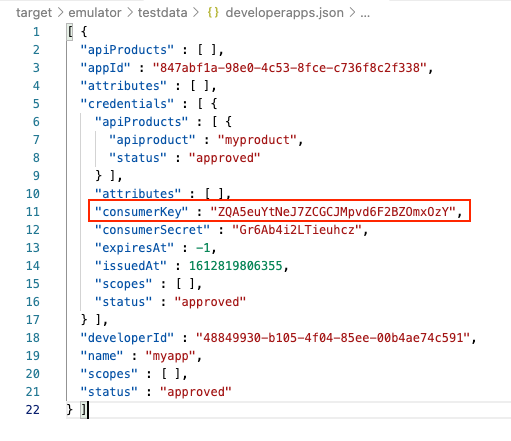이 페이지는 Apigee 및 Apigee Hybrid에 적용됩니다.
Apigee Edge 문서 보기
![]()
다음 섹션의 설명대로 API를 테스트합니다. Apigee 작업공간의 폴더 및 파일 관리도 참조하세요.
API 프록시 엔드포인트의 URL 확인
환경을 배포하면 활성 배포 아래에 에뮬레이터 섹션의 API 프록시 엔드포인트의 URL이 표시됩니다.

API 프록시 엔드포인트의 URL을 복사하려면 URL 위로 커서를 가져가고 ![]() 을 클릭합니다.
을 클릭합니다.
API 프록시 엔드포인트의 URL은 다음과 같이 구성됩니다.
https://0:8998/shopping/cart/addItem
|_____||____________||______|
| | |
host+port basepath resource
기본적으로 호스트와 포트(트래픽)는 각각 0와 8998로 기본 설정됩니다.
Apigee 에뮬레이터를 설치할 때 포트를 정의하고 API 프록시를 개발할 때 기본 경로 및 리소스 값을 정의합니다.
curl을 사용한 API 테스트
curl을 사용하여 API를 테스트하려면 터미널 탭을 열고 API 호출을 실행합니다.
예를 들면 다음과 같습니다.
curl 0:8998/helloworld
API 키를 사용한 인증
API에 API 키 기반 인증이 필요한 경우 다음을 수행하세요.
- 테스트 리소스 빌드의 설명에 따라 API 제품, 개발자, 개발자 앱 테스트 리소스 빌드 및 내보내기
다음 그림과 같이 Apigee 에뮬레이터의 활성 테스트 리소스 섹션에서 활성 개발자 앱을 클릭하고 API 제품의
consumerKey값(따옴표 없이)을 복사합니다.
API의 필요에 따라 curl 호출에 API 키를 전달합니다. 예를 들어 다음 curl 호출은 apikey 쿼리 매개변수에 API 키를 전달합니다.
curl 0:8998/helloworld?apikey=ZQA5euYtNeJ7ZCGCJMpvd6F2BZOmxOzY
